Former miners suffer from coal nuggets in their chests
Pneumoconiosis, commonly called black lung disease, is the most common work-related disease in China with approximately 6 million sufferers, according to official estimates. In addition to the heavy financial and mental burden that the disease inflicts on the victims, the complicated legal compensation process and lack of public health support make it even more difficult for victims to breathe easy.
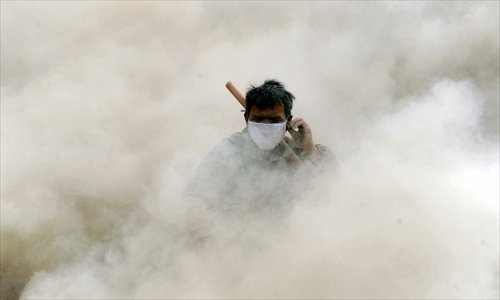
A worker is surrounded by dust at a quarry in Aksu, the Xinjiang Uyghur Autonomous Region, on September 4, 2012. Photo: CFP
It was a semi-live lung transplant. On the microblogging site Weibo, millions of netizens looked at the black lungs of Ren Nengping, removed from him mere minutes before, when Liu Feng, a surgeon from Wuxi People's Hospital, posted its image on his account on January 6.
"Look at this sick lung… The solid black nuggets are the sedimentation of coal dust. The biggest one is as long as 10 centimeters in diameter, while this one is 4 centimeters in diameter. Now a new lung is being transplanted," he wrote.
From the organ donation surgery to the delivery of the donor's lungs, to all the health checks that Ren went through before the surgery, each step of the transplant was posted on Weibo. Updates about Ren's lung transplant drew the attention of over 66 million netizens in total.
The surgery was the last step for terminal patient Ren, a 38-year-old black lung disease patient. Last July, when actress-turned-activist Yuan Li met Ren at his home in Xiangyang village in Shangluo, Northwest China's Shaanxi Province, the first thing she saw was the coffin that Ren had prepared for himself, sitting in his living room. He was nothing more than skin and bones, and had to sit in bed all day because of his breathing problems.
Ren started to work at a gold mine in Central China's Henan Province in 1995, and that's how he got pneumoconiosis, the most common occupational disease in China caused by inhaling metallic or mineral particles or gas which become lodged in sufferers' lungs. According to a report by China's National Health and Family Planning Commission last year, among the 29,972 diagnoses of work-related diseases in 2014, 89.66 percent were pneumoconiosis cases.
Yuan was researching the health of pneumoconiosis patients with Love Save Pneumoconiosis, a non-governmental group founded by Wang Keqin, an investigative journalist, dedicated to raising awareness of the disease and providing help for sufferers. Several months after the trip, with the support of Chen Jingyu, a leading lung transplant surgeon in Wuxi, East China's Jiangsu Province Yuan decided to donate 400,000 yuan ($60,840) to help a black lung disease patient get a new set of lungs. She thought of Ren.
Despite all the attention and blessings, three days after the surgery, Ren died of complications from the surgery. The transplant failed.
Ren's live lung transplant and his death drew public attention once again to pneumoconiosis, the slow, silent killer that has caused the deaths of hundreds of thousands of people working under horrible conditions, and impoverished many more.
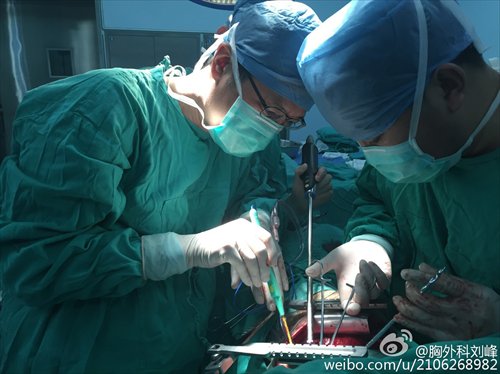
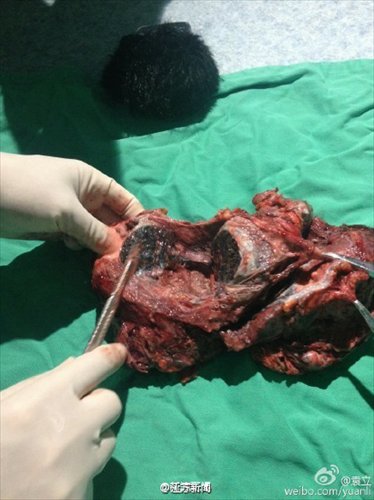
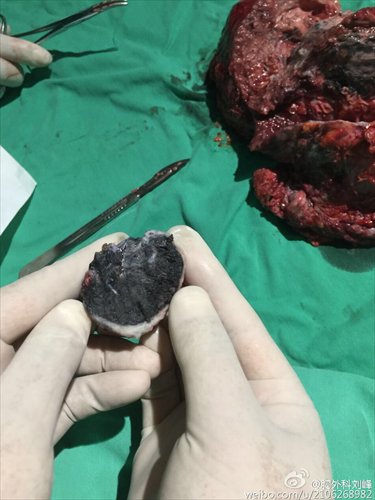
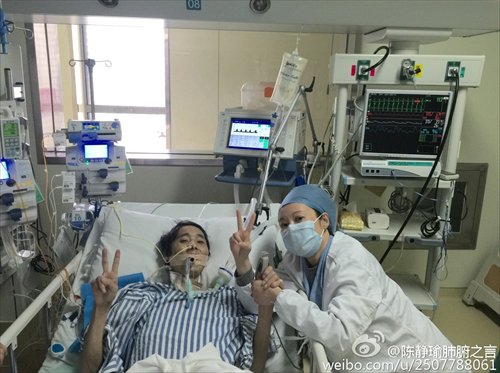
Photos posted by surgeons on Weibo show their lung transplant operation on Ren Nengping and the coal nuggets taken from Ren's lung. Photos: Courtesy of Sina Weibo
Pain and poverty
China's history of pneumoconiosis is closely connected with its economic boom. Most black lung patients started to develop the disease in the late 1980s and early 1990s, when reform and opening up lead many of them to work in dangerous industries such as mines and metal factories.
The exact number of black lung sufferers in China is not clear. According to the Ministry of Health, there were over 700,000 diagnoses of pneumoconiosis in China in 2013, a number growing by over 20,000 cases a year, but Love Save Pneumoconiosis says the actual number of sufferers could be 10 times bigger, exceeding 6 million, since the majority are never diagnosed. Due to the lack of treatment, as many of 22 percent of black lung sufferers will die of the condition.
Having pneumoconiosis means losing one's ability to work. According to a report by Love Save Pneumoconiosis, 78.8 percent of pneumoconiosis patients find it hard to walk around, and 76.5 percent find daily activities difficult. Many patients will get out of breath just walking around their homes.
Many pneumoconiosis patients have to breathe with the help of an oxygen tank, and their life is lived tethered to a plastic pipe just a few meters long. When the disease is at its final stages, many have to kneel down several times a day and even while sleeping in order to alleviate the pain in the lungs.
Dai Chun, founder and former director of the Hunan office of Love Save Pneumoconiosis, has been working to help pneumoconiosis sufferers since 2012, and said black lung can often be found concentrated in some villages, as villagers in the same community often work at the same mine or factory. In Shifosi village in Shaanxi Province, for example, in its 500 households, 100 adult men had pneumoconiosis. Most of them had worked in the local gold mine since the late 1980s.
Since most of patients are also their household's breadwinners, getting the disease often means they will live in poverty and debt. According to a report by Love Save Pneumoconiosis, over 74.5 percent of sufferers have debts, and among families with deceased patients, that number is over 91.8 percent.
Looking for gold
Although pneumoconiosis is a work-related disease, seeking compensation from employers can be a daunting task.
According to China's Law on the Prevention and Control of Occupational Diseases, one needs to prove one's labor relationship with the employer, and provide proof of diagnosis to prove the connection between one's disease and job.
In reality, many migrant workers did not sign employment contracts with their employers in the first place, making it hard to prove that their employer is responsible. Even if they have signed contracts, according to China's law, to obtain proof of diagnosis of their occupational diseases would require their employer's consent and signature. Most employers are not willing to allow their workers to receive such a diagnosis.
The difficulty of diagnosis prompted Zhang Haichao, a migrant worker from Central China's Henan Province, to go through open chest surgery in 2009 to prove he actually had pneumoconiosis. That incident drew nationwide attention and donations, which helped Zhang get a lung transplant.
Seven years have passed, and the legal environment for upholding the legal rights of pneumoconiosis patients hasn't improved, Liu Jianwei, a pneumoconiosis sufferer and an activist, told the Global Times.
Liu started work at a jade factory in 1988 in Shunyi district, Beijing. From 2006 onwards, he and his wife, sister and brother were diagnosed with pneumoconiosis. Through six years of continued efforts, he managed to win compensation for him and over 10 colleagues. Now, he provides legal assistance to sufferers who want to seek compensation, while working as an air-conditioner cleaner.
The time and effort that are required to apply for compensation is daunting. Statistics show that on average, it takes 23.5 months to complete the compensation process, and in the process one has to pay between 7,000 and 70,000 yuan in legal costs. "Many factory owners would appeal or object to a diagnosis on purpose, just to delay the process of compensation. A sufferer could die waiting for that legal process to end," Liu said.
Breath of fresh air?
Liu Jianwei is calling for the legal procedures required for pneumoconiosis sufferers to seek compensation to be simplified. "Too many people die before they can complete those complicated legal procedures. Local governments should provide workers who are unable to prove their employer's liability with life and medical assistance," he said.
The work activists and NGOs are doing is paying off, at least on paper. On January 20, 10 central government departments, including the National Health and Family Planning Commission, the Administration of Work Safety, the All China Federation of Trade Unions and the Ministry of Science, jointly issued a notice on strengthening the prevention and treatment of pneumoconiosis. The document calls for rigorous safety checks in workplaces, more frequent health checks organized by employers, and the inclusion of pneumoconiosis treatment and medication in healthcare programs.
Although the implementation and enforcement of the notice remains to be seen, it's the first document in almost 20 years that targets pneumoconiosis specifically. "It's huge progress," Dai Chun, the volunteer with Love Save Pneumoconiosis, told the Global Times.
"There are so many pneumoconiosis patients with such huge needs that it the central government has to take initiative in the prevention and treatment of the disease. It's very difficult for local governments to solve these problems on their own," she said.
Newspaper headline: Black lungs